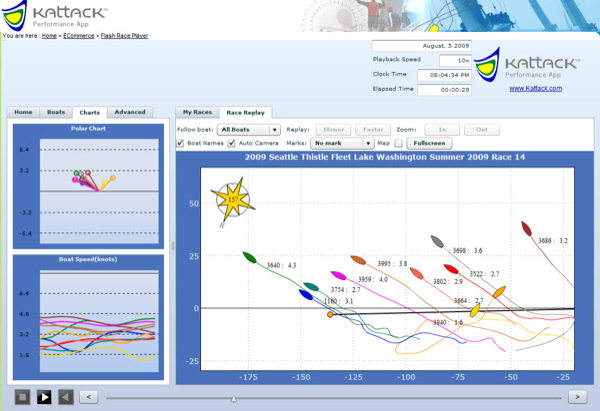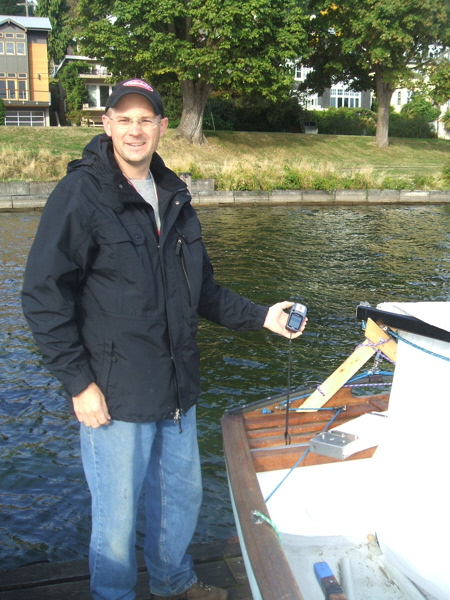
CYC Home
By Jen Wisemore
Seattle Thistle Fleet
During the latter part of the season of 2008, the Thistle fleet started experimenting with the Kattack Race Analysis system. Our purpose was solely for training as the class rules forbid electronics for any class racing.
We initially used the Seattle North Sails Kattack license, but due to the frequency of racing and the number of boats using the units, we received a trial fleet license from Kattack so we could manage the system ourselves and take the workload off the North Sails office.
For the 2009 season, thanks to some generous donors, the fleet was able to purchase 10 handheld GPS units to loan out for weekly club racing. CYC contributed towards the Kattack license and the rest was paid from our fleet funds.

A Kattack screen shot of the Thistle fleet shortly after starting.
A fleet GPS unit is assigned to each boat for the evening, or the boat owner has their own GPS unit. The units can be basic ones such as the Garmin eTrex Legend. These are the types used for hiking or other personal navigation (different than the car navigation units).
We purchased refurbished ones from an online retailer for the fleet for approximately $100 each. At the start of racing for the evening, the GPS units are turned on and then placed in an aft tank, tied to the transom grate, or in a dry bag. As they are not used directly during the race (just too record information) there is no need to see the units while racing.
Boats leave the dock and race as usual. Upon returning to the marina, the units are collected and given to a designated volunteer for uploading. Via a USB connection and the Garmin software, the data is uploaded from the units to a PC. After uploading the files are emailed to the fleet Kattack administrator (fleet volunteer).
Skippers that own their units upload and email the file directly to the administrator. The administrator loads the data into the web based Kattack system. Some clean-up is required such as putting boat numbers on the data, marking the starting line, and cutting out the "dead time" in between races and to/from the docks.
Once the tracks are uploaded, the administrator emails the fleet distribution list that the tracks are available for viewing. Generally this finished within 24 hours of the race so it's still fresh in everyone's mind. Along with the notice that the tracks are ready he often writes a quick synopsis of the night's racing or any particular brilliant tactical move by a boat.
The Kattack Race Analysis program processes GPS track data to provide information such as: boat speed, VMG, angle (pointing), distance and time. Races are replayed in a free virtual race player. Kattack provides two ways to view the race tracks - a web-based view that requires no software installation on the local machine or a PC client versions (Windows and Mac). Racers review the tracks at their leisure. Email banter will fly back and forth on race tactics and results
Thistle fleet races can be viewed free at: http://www.kattack.com/ under the Seattle Thistle Fleet club.
Doug Stumberger, Bagpipe Magazine Article (our Class Magazine)
"Our fleet has always been welcoming to new members. We share go-fast ideas, hold "crew change and improve" nights, and congregate in the parking lot to discuss the evening's racing. Our use of Kattack fits right into that pattern and is particularly useful for sailors who are new to the sport (not just new to a Thistle) - precisely the sailors we are all working so hard to attract and retain in the class. Being able to see the decisions that more experienced sailors made in a race has helped new members learn about tactics and strategy…In essence, we view Kattack as a coaching tool, and so far it has been a great success!"

Thistler Rusty Lhamon with one of the GPS units used to track the boats.
Five Anonymous Fleet Members
"Replaying the race via Kattack has many uses, but we've found several have really helped us improve our game. By watching the actual boat track, you can graphically see the course steered and how far off the rhumb line. By comparing to other boats, we could see that we were consistently sailing further than others. Kattack makes examining the downwind tacking angles much easier to see. It also computes comparative metrics like total distance sailed per leg. Wind shifts are perhaps the most visible. The better boats tack quickly on the shifts. Kattack enables you to see the cost of not tacking on a shift. Perhaps in summary, it solves the 'What the heck happened' question. You can see exactly why you lost or gained places. We've done a bit of blogging in conjunction with the Kattack replay and the fleet seems to quite enjoy the race and commentary."
"Being a mid fleet boat, it's been great to watch our sailing angle and speed against some of the upper fleet boats. It has cleared up some perception problems and helped us focus on specific issues which are far more obvious in review on the tracks then it is in the heat of the race."
"It showed me this season that each boat had a kind of 'signature' for how their tacks looked. Some boats tacked steep and quick, some shallow, etc. By looking at your track, you could start to understand how some of the faster boats were tacking and adjust boat handling to match. There's really no other way to see that 'signature.' Even video analysis, while helpful, isn't as useful in that regard."
"The replay also helps review starting strategies related to acceleration off the line line sag, tactics related to wind shifts and favored end of the line. It also helps you see how well you protected your space."
"Kattack provides me an objective way to measure my sailing progress. But what I really enjoy is that my kids (age 7 and 9) love to watch the race replays with me. We've had some great tactical discussions and they are developing more interest in racing."
Ed. note: there is an article on our website about using Kattack for the 2008 Possession Point Race. This may have useful information about how to get the software and some more details about using it